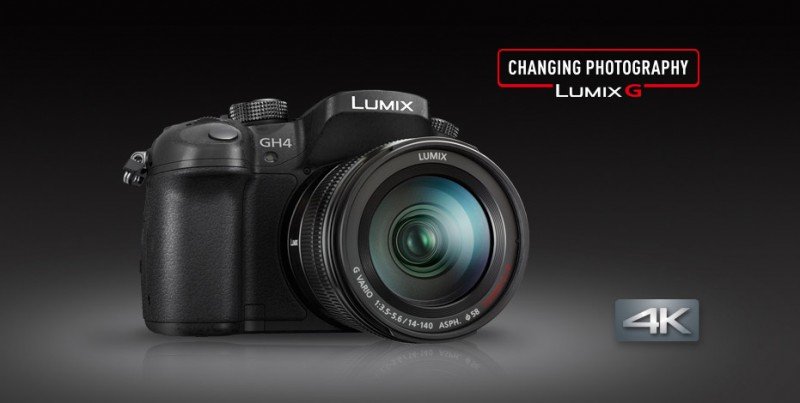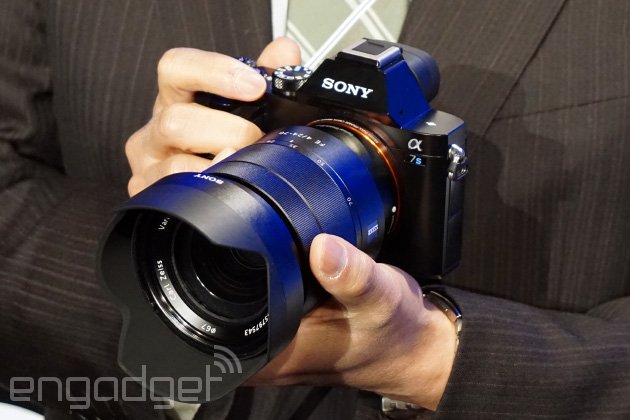
Image Source: Panasonic
A few weeks ago, Panasonic announced their GH4 camera. Capable of shooting 4K and Ultra-HD video, with four times the resolution of 1080p (or “full-HD”), this camera got a lot of shooters, myself included, pretty excited. In fact, I got so excited, that I pre-ordered two of them.
Yesterday, Sony announced their 4K-capable competitor to the Panasonic GH4, the Sony a7s. On the face of it, this is a pretty similar camera to the Panasonic GH4, but dig deeper and it takes a fundamentally different approach to shooting video.
Now, it’s worth me stating very clearly at this point that I haven’t used either of these cameras yet, in fact, I haven’t even touched or seen them, so I’m not going to be giving a detailed appraisal of the image quality of each. There’s a little bit of footage out there already from each camera. Andrew Reid over on EOSHD has shown us some really interesting stuff using a pre-production GH4 (see here, here, here and here) and Den Lennie of F-stop Academy has posted some nice footage from a pre-production Sony a7s (see here). I’m not going to go too crazy analyzing Andrew and Den’s footage and I’m not going to steal their traffic by re-embedding their videos, but do head over to their sites and have a look for yourself.
So, the Panasonic GH4 and Sony a7s are basically the same, right? Well, not really. They’re both small cameras that shoot 4K video but they do it in very different ways.

Image Source: Engadget
Internal Recording vs. External Recording
I’m really excited about the Panasonic GH4. I still own a couple of GH2’s and, while I normally pick up my Canon’s and I passed on the GH3, I’m very seriously considering the switch back over to Panasonic with the GH4. The Panasonic GH4 shoots full, cinema 4K (4096 x 2160 pixels) and “Ultra-HD” (3840 x 2160 pixels…exactly four times the area of 1080p) internally, to very fast (and pretty expensive) SD cards. This internal 4K is recorded in 8-bit colour depth giving 256 shades of Red, Green and Blue, at 4:2:0 colour resolution (see THIS ARTICLE for a bit more info about colour sub-sampling). It can also output these resolutions through the HDMI port to an external recorder (we’ll get onto those later). This bumps the colour depth up to 10-bit, allowing 1,024 different shades of Red, Green and Blue for smoother colour gradation and less “banding”, and also increases the colour sampling to 4:2:2.
The Sony a7s doesn’t record any kind of 4K or Ultra-HD footage in-camera at all. To do this, you HAVE to use an external recorder and, to make matters worse, the Atomos Shogun, the only currently-announced recorder that doesn’t have to be plugged into the wall, isn’t going to be available until the end of Q3 or the start of Q4 2014 (I’d guess around September/October time if all goes to plan).
The footage recorded to the card in the a7s is 1080p, 8-bit, 4:2:0. By using an external recorder, you can capture Ultra-HD footage (I’m not yet sure if you can capture true 4K or “only” UHD) with 4:2:2 colour sampling. It’s worth noting that, unlike the GH4, the signal that comes out of the a7s’ HDMI port is 8-bit only; even when using a recorder that can capture 10-bit footage, you will only get 8-bit. This can be important when really trying to maximise dynamic range using very flat picture profiles, as spreading those 256 values over a very wide range can result in ugly banding in the footage. Whether this proves to be a problem or not, remains to be seen.
Sensor Size, Pixel Size and Resolution
Both cameras take an equally different approach to sensor size and resolution. The Panasonic GH4 uses a 16 (ish) megapixel, Micro Four-Thirds sensor. The Sony a7s uses a full-frame sensor, roughly twice the width and height, or four times the physical area, of the one in the GH4. Sony have also chosen to use a comparatively low sensor resolution of 12 megapixels. I really applaud this decision by Sony. Going against the “megapixel race” is a risky strategy from a marketing perspective (a lower number is worse, right?!), but something that many people, myself included, have been wishing would happen for ages! Reducing the megapixel count increases the physical size of each pixel. This means that each pixel can suck in more light, making the camera far more sensitive when light levels start to drop (the “s” in a7s actually stands for “sensitive”). Bigger pixels also tend to mean wider “dynamic range”, allowing the camera to capture a wide range of subjects- from the darkest darks to the brightest whites- in the same image. This wide dynamic range can really contribute to a nice “film look”. The only down-side of this lower resolution is really for those who want to make huge prints from their still photos. They’re probably best to stick with Sony’s 36 megapixel a7r, but for the rest of us who only print up to A3-ish prints, 12 megapixels is normally plenty.
The smaller sensor in the GH4, with its higher resolution, has much smaller pixels so the Sony a7s is likely to be a fair bit cleaner in low light. I do think it’s worth a reality check on this, though. Andrew’s GH4 low light tests over on EOSHD looked pretty positive. To my eye, the GH4 didn’t look far off the Canon 5D Mark III in Magic Lantern raw mode; a camera which I think is a great low-light shooter. The GH4 also looked streets ahead of the GH3 in low light. I’m sure the a7s will be a mind-blowingly good low-light camera, but will the GH4 be good enough for 95% of things? I guess we’ll find out soon.
Depth of Field
That full-frame sensor in the a7s is definitely going to result in shallower depth of field. Personally, I’m not an extreme shallow depth of field junky when it comes to video and you won’t often catch me at 85mm and f/1.2. It’s just not a look that I’m a big fan of and I think it’s become a bit clichéd. However, I do like a nice soft background as much as the next guy and this comes a lot more conveniently on the a7s than on the GH4. On an a7s, even a relatively slow, f/4 lens will give you a decent amount of separation between you subject and the background in a lot of circumstances. This, coupled with what we expect to be exceptional low light performance, could mean that you could pop a nice 24-105mm f/4 zoom lens (with an image stabiliser) on the camera and shoot away. To get the same depth of field on the GH4, you’d be looking at shooting at around f/1.8 to f/2 which is into prime lens territory. This is going to mean a lot more lens changes and a lot more time to get your shots. Sometimes, that’s not a problem but, if you do a lot of run-and-gun shooting where time is tight, it might become a factor.
There are ways around this. The Metabones Speedbooster allows you to use Nikon lenses on your GH4 and, using this, an f/2.8 zoom would give you pretty similar depth of field to an f/4 zoom on the Sony a7s. However, there isn’t yet a Canon version of the Metabones Speedbooster and the Nikon version doesn’t support image stabilisation (or Vibration Reduction if you speak Nikon). The only way to get an image stabilised, general purpose zoom lens on the GH4 at the moment, is to use the Panasonic 12-35mm f/2.8, giving you roughly similar field of view and depth of field characteristics to a 27-80mm f/6.3 on the a7s. It’s alright, but it’s not great.
For me, if Metabones release a Canon EF to Micro 4/3 version of their Speedbooster that supports image stabilisation, this concern evaporates. Just buy a Canon 17-55mm f/2.8 IS, pop it on the Speedbooster and crack on!
Stills Quality
To be honest, this gets into the realms of wild speculation. I’d imagine that the low light quality from the a7s will be spectacular while that from the GH4 will probably be pretty similar to the GH3; not awful but nothing special. I’d imagine that the same will go for the dynamic range, while I expect this to be pretty spectacular in the a7s. The 36 megapixel Sony sensor in their a7r (and also in the Nikon D800 I believe) packs a very impressive 14 stops of dynamic range. If they can do that with a 36MP sensor, what can they do with a 12MP one?!
There’s also a bit of a lack of third-party accessories for the Panasonic’s Micro 4/3 format. For example, I’d love to see Phottix release a Micro 4/3 version of their Odin radio flash triggers which I use and love with my Canon gear. Panasonic did announce their DMW-FL580L flash alongside the GH4, though I haven’t heard much more about it. That features wireless triggering (by radio I think) so might fill that particular hole, albeit at a fairly heft price tag.
Also, having said that I’m not a shallow depth of field junky, I do tend to shoot wide open more often when taking stills. There are certain full-frame “looks” that I love and that I would miss if moved to the Micro 4/3 format. For example, you can’t mimic the look for a 24mm f/1.4, wide open on a full-frame sensor. It’s just cool!
Other features
Both cameras have a whole host of other features that might be important to you. The GH4 shoots 1080p slow motion at up to 96fps while the Sony a7s does 120fps but only at the lower resolution of 720p. I’ve seen a little bit of the 96fps footage from the GH4 and no slow-mo at all from the a7s, so it’s still too early to know how these modes will actually hold up.
Both cameras have an optional interface box. The DMW-YAGH, a brick of a thing for the GH4 that requires external power, gives it timecode-in, SDI ports and XLR audio ports. There’s a similar, but much more ergonomically-friendly-looking adapter for the a7s (which I think is THIS) to give it XLR audio ports and a top mic. For my purposes, I think I’d just stick to my JuicedLink Riggy Micro for audio and my Atomos Connect HDMI-to-SDI convertor (albeit, that can’t do 4K…I assume). The timecode-in on the GH4 is a nice touch.
Conclusion
Well, I can’t really make your mind up for you I’m afraid! At the moment, I’m leaning towards the GH4 on specs alone, especially if Metabones bring out a Canon EF Speedbooster for it. I like the idea of being able to shoot 4K in a small package, with the ability to build it up for extra quality, only when I need to, and the EOSHD footage looks pretty damn nice! I do really like Sony’s low-megapixel, big-pixel approach and I could yet be swayed if the image is right. The lack of internal 4K is disappointing but I’m sure we’ll see plenty of 4K recorders coming onto the market in the not too distant future.
It’s an exciting time for us camera geeks!






Hans
I’m sorry, but micro four thirds is about one fourth of the full frame sensor.
Ross Fairgrieve
It depends if we’re talking about diagonal length, and therefore “crop factor”, or area. I’ve updated the article to clear that up.
Thanks,
Ross
John P
I’m leaning gh4 currently myself. Having to purchase an add-on box for 4k kinda defeats the purpose of a dslr in the first place. I’n sure the A7’s gonna be great, but I’m going to pass since I believe Sony will have something with internal 4krecording soon anyway and the A7 seems like a rush job for not having this from the start. For now, the codecs on the GH4 are better for 4k and 1080 and we haven’t seen any examples from the A7 yet that show any real camera movement. The rolling shutter from this beast just might be terrible. We still don’t know.
Ross Fairgrieve
Yeah, I guess we’ll just have to wait for a bit more footage to make it into the wild. I have to say, I’ve seen a couple of things in the little bit of a7s footage that’s around, that does look worryingly like it could have a bit of a rolling shutter problem. I hope I’m wrong!
online auto insurance cheap
Wham bam thank you, ma’am, my questions are answered!
Roger Martin
The 4k Odyssey 7Q does not have to be “plugged into the wall”.
It comes with a choice of battery plates including one for the Sony F970.
The codec is included for 1080 P60 and 4k recording.
It has a 7 inch high resolution touchscreen.
Downside is up to two $400 + propietary SSD discs are necesary for recording.
They were announced about this time last year and are available now.
Ross Fairgrieve
It’s a nice idea Roger but the Odyssey7Q doesn’t support 4K over HDMI, only over SDI which the Sony a7s doesn’t have. I think the HDMI port on the Odyssey7Q is HDMI 1.4, not the newer and higher bandwidth HDMI 2.0 which is needed for 4K, so it’s unlikely that Convergent Design will be able to enable 4K recording via HDMI with a firmware update.
Darren
A7S with 10 Bit output. Job done. Why is it when you think a manufacturer has just ticked all the boxes they fall short in what is to me a vital and important area! Wonder if this could be fixed with a firmware update or the people at Magic Lantern could hack it. I have a feeling probably not as I would speculate it is a hardware limitation. I would have bought this camera but am not going to now and instead wait to see what Canon do with the 5DMkIV. Other than that a great camera.
Ross Fairgrieve
Yeah, I agree with you on that Darren. In a lot of cases, I don’t think 10-bit is that critical but, when Sony are including a very flat Slog-2 gamma curve and going the low megapixel, high dynamic range route, it screams 10-bit! I certainly think the HDMI out should have been 10-bit, even if the internal recording was only 8-bit.
Mike Allen
If Sony would only implement 10 bit 4K output and a global shutter on the A7s, they would easily corner the market and wipe everyone else out. Instead, naturally, they are short-sighted, looking to protect their pro division, and therefore they deliberately limit the usefulness of anything at this price point. Blackmagic is the only company doing its level best to keep pushing the envelope in order to give customers the best bang for the buck. Unfortunately, massive companies like Sony and Panasonic have much more experience behind them, so it is hard for the super cool upstarts like Blackmagic to catch up…
Ed
Having had a GH2 and a GH4 for production (produced a very nice music video for a client using a ‘hacked’ GH2 and it was incredible. Behaved very (I mean VERY) close to a C100. Not many issues with noise. Love the camera. Strapped an Angenieux to it and it sings. Its like a ballerina.
The GH4? Oh dear. Oh dear. (Repeat 10 times more). Did this really come from the same stable? If so then its a mule and it does not carry anything but insidious criticism. Defending the GH4 is a lot like Windows users trying to defend Microslop in comparison to the Mac.
The GH4 is a noise monster. Noise. As in those little flies that love dancing around in darkness. Even at its lowest setting of 320 its like singing in the rain in the shadows (and most other times in everything else that thinks its a shadow).
Add VLOG to it (which I did and it cost me nearly a 100 quid) and it is worse. Not to mention the fact that it shoves you up an ISO setting to 400. I have seen less grain in a barrel of barley. I produced far better results in manually ‘tuning’ the camera and filming in Cinelike D.
You might ask what I shot it with, how I shot it (TTR or any other magic you can add) but since I have been ‘digitally’ filming since Back to the Future promoted the GH1 and owned and used the ‘Mac Daddy’ of cameras with the Sony PC120, along with every pro camera with a 3CCD chip for high end work, I should know cameras.
OK, I am being unfair. The GH4 LOVES light (best shot on the surface of the sun, I hasten to add) but what camera doesn’t like tons of light? But if using the GH4 then phone rent-a-turck-of-light and have them truck in about 10 times the amount you think you need.
I need a broad stretch on a cam (not talking about ‘Dynamic Range’ since the GH4 has about 2 under its 8 claim so not really dynamic and no range at all) It is not a pain to work with. It is a nightmare. The menus are like a chapter of War and Peace and elements I loved on the GH2 for quick ‘run n gun’ work have been well and gotten rid of. Panasonic, what WERE you thinking when you designed this filmmaking wanna be?
No idea, but time to wake up before you shove the new replacement claiming to film in 6k. You need to get rid of the noise not ask pop group, Slade to order you some. (Showing my age. Standard).
This camera is seriously not worth the hype (which i bought it on the back of and did extensive research) and does nothing like that wonderful Paris promo on YouTube (which looks like it was probably a Panasonic commission and made with a Red).
Oh jeepus. The GH4, along with its set of quite expensive (and very stiff zoom and focus) pieces of plastic has now been laid to rest with a new owner whom I wish a lot of luck, a lot of prayer (he might need that from the depression he will certainly suffer) and I wish him well.
Me? I’m looking at either a Sony A7s ii (poignant given the post) or a Sony FS700R. Or a Red Raven if I can sell the wife and her two Chihuahuas.
OK, I am being unfair. I love dogs. Maybe I will loan Casey Neistat my wife. He seems to lose everything.
Pity I cannot find a decent, low light, high spec, WDR and 4k beast. Somewhere. On this planet. Oh me.
Ross Fairgrieve
Haha, that’s definitely one of the most entertaining camera-based comments that I’ve read on here! I agree about the noise on the GH4. I owned one for a bit and just couldn’t get on with it in anything other than really controlled lighting situations. I’ve got an A7s original and, in the non-log modes, the image is very clean but the highlights are a bit weird and make people look like they’re glowing (less in the “joys of spring” way…more “winter vomiting bug”). In S-log2 the dynamic range and highlight roll-off are nice but the noise floor does start to become apparent and you have to find/build a good LUT to deal with it rather from twiddling sliders and hoping for the best. From my experience, the FS700 has horrible highlight roll-off when not shooting in Slog and a weird purple-y blue tint that’s really hard to get rid of. I plucked for an FS7 which has proved to be really, really nice. Combine it with some flavour of Bert Degraeve’s Arri-like LUT for S-log3 and you get nice clean footage with buttery smooth highlights and really nice colours. It’s not cheap though and you might have to add the cost of a good chiropractor by the time you beef up tripods, sliders etc.